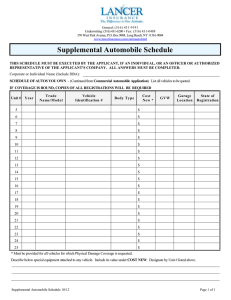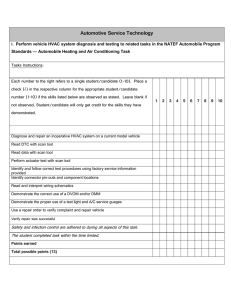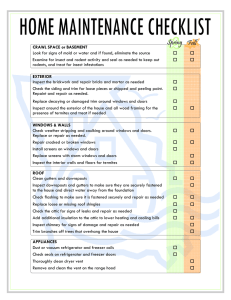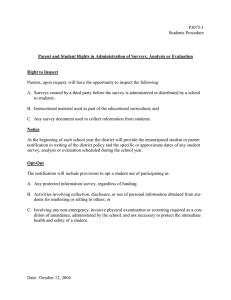Automotive Service Technology - Central New Mexico Community
advertisement
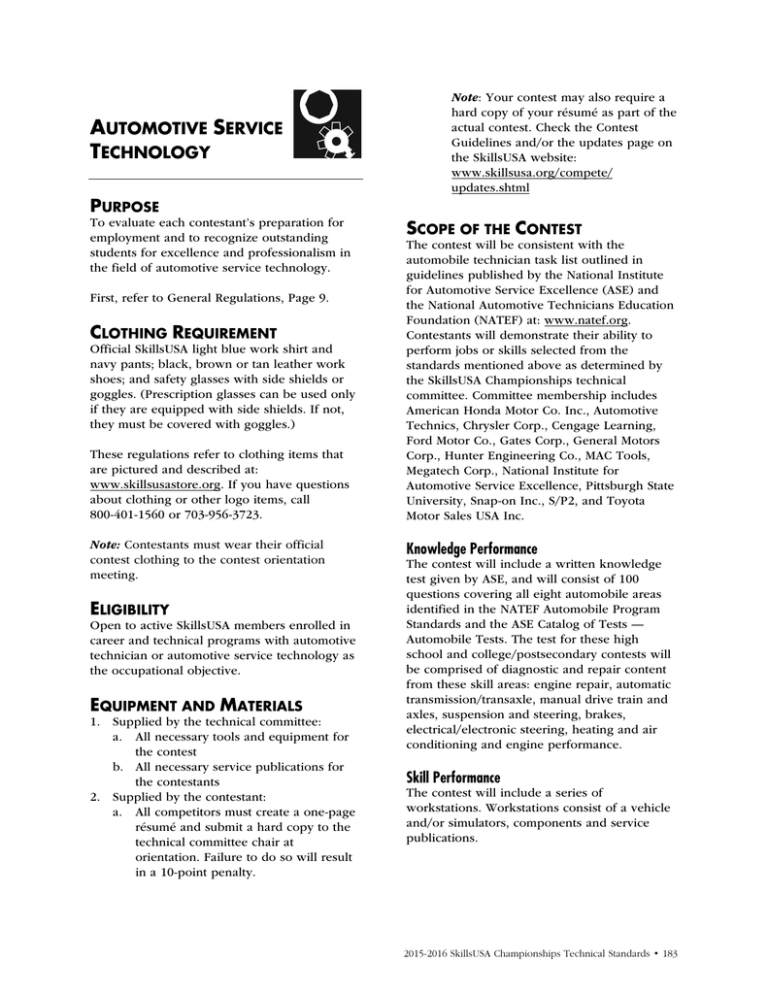
AUTOMOTIVE SERVICE TECHNOLOGY Note: Your contest may also require a hard copy of your résumé as part of the actual contest. Check the Contest Guidelines and/or the updates page on the SkillsUSA website: www.skillsusa.org/compete/ updates.shtml PURPOSE To evaluate each contestant’s preparation for employment and to recognize outstanding students for excellence and professionalism in the field of automotive service technology. First, refer to General Regulations, Page 9. CLOTHING REQUIREMENT Official SkillsUSA light blue work shirt and navy pants; black, brown or tan leather work shoes; and safety glasses with side shields or goggles. (Prescription glasses can be used only if they are equipped with side shields. If not, they must be covered with goggles.) These regulations refer to clothing items that are pictured and described at: www.skillsusastore.org. If you have questions about clothing or other logo items, call 800-401-1560 or 703-956-3723. Note: Contestants must wear their official contest clothing to the contest orientation meeting. ELIGIBILITY Open to active SkillsUSA members enrolled in career and technical programs with automotive technician or automotive service technology as the occupational objective. EQUIPMENT AND MATERIALS 1. 2. Supplied by the technical committee: a. All necessary tools and equipment for the contest b. All necessary service publications for the contestants Supplied by the contestant: a. All competitors must create a one-page résumé and submit a hard copy to the technical committee chair at orientation. Failure to do so will result in a 10-point penalty. SCOPE OF THE CONTEST The contest will be consistent with the automobile technician task list outlined in guidelines published by the National Institute for Automotive Service Excellence (ASE) and the National Automotive Technicians Education Foundation (NATEF) at: www.natef.org. Contestants will demonstrate their ability to perform jobs or skills selected from the standards mentioned above as determined by the SkillsUSA Championships technical committee. Committee membership includes American Honda Motor Co. Inc., Automotive Technics, Chrysler Corp., Cengage Learning, Ford Motor Co., Gates Corp., General Motors Corp., Hunter Engineering Co., MAC Tools, Megatech Corp., National Institute for Automotive Service Excellence, Pittsburgh State University, Snap-on Inc., S/P2, and Toyota Motor Sales USA Inc. Knowledge Performance The contest will include a written knowledge test given by ASE, and will consist of 100 questions covering all eight automobile areas identified in the NATEF Automobile Program Standards and the ASE Catalog of Tests — Automobile Tests. The test for these high school and college/postsecondary contests will be comprised of diagnostic and repair content from these skill areas: engine repair, automatic transmission/transaxle, manual drive train and axles, suspension and steering, brakes, electrical/electronic steering, heating and air conditioning and engine performance. Skill Performance The contest will include a series of workstations. Workstations consist of a vehicle and/or simulators, components and service publications. 2015-2016 SkillsUSA Championships Technical Standards • 183 1.2.3 Contest Guidelines 1. 2. 3. 4. 5. 6. 7. A variety of vehicles sold in the United States will be used in the contest. This will include both domestic and imported vehicles. Some or all of the high-school work stations may be different than the college/postsecondary work stations. Safety, quality, ability to follow instructions and procedures, accuracy (in comparison with factory specifications), workmanship, and other skills representative of the trades identified by industry leaders will be judged. A total of eight to 15 stations will be assigned. Each station must be broken down into specific task criteria and separate steps based on the task. For example: Station No. 1 Wire test and repair segments Identify faulty circuit = x points Repair condition = x points Assemble/retest = x points Resistor board tests = x points Compare values to specs = x points Workmanship = x points Safety practices = x points The points allowed for each station will be assigned by the national technical committee and will be based on the difficulty of each assigned task. Time limits will be assigned for each task, but no bonus points will be awarded for early completion. Stations and equipment to be used in the national competition will be published annually by April 15 in the SkillsUSA Championships contest updates. Standards and Competencies: High School AST 1.0 — Perform vehicle HVAC system diagnosis and testing to related tasks in the NATEF Automobile Program Standards — Automobile Heating and Air Conditioning Task List (ASE Test A7) 1.1 Diagnose and repair an inoperative HVAC system on a current model vehicle 1.2 Use a provided factory scan tool for current model vehicle 1.2.1 Read DTC with scan tool 1.2.2 Read data with scan tool 184 • Sponsored by Goodheart-Willcox Publisher 1.3 1.4 1.5 Perform actuator test with scan tool Use factory service information provided 1.3.1 Identify correct test procedures 1.3.2 Follow the correct test procedure 1.3.3 Identify connector pin-outs 1.3.4 Identify component locations 1.3.5 Read and interpret wiring schematics Use provided test equipment 1.4.1 Use a DVOM or DMM 1.4.2 Use a test light 1.4.3 Use A/C service gauges Use a repair order 1.5.1 Verify complaint 1.5.2 Repair vehicle 1.5.3 Verify repair was successful 1.5.4 Identify components in the system AST 2.0 — Perform vehicle engine performance diagnosis and testing to related tasks in the NATEF Automobile Program Standards — Automobile Engine Performance Task List (ASE Test A8) 2.1 Diagnose and repair an engine performance issue on a current model vehicle 2.2 Use a provided factory scan tool for the current model vehicle 2.2.1 Read DTC with scan tool 2.2.2 Read data with scan tool 2.2.3 Perform actuator test with scan tool 2.3 Use factory service information provided 2.3.1 Identify correct test procedures 2.3.2 Follow the correct test procedure 2.3.3 Identify connector pin-outs 2.3.4 Identify component locations 2.3.5 Use wiring schematics 2.4 Use provided test equipment 2.4.1 Use a DVOM or DMM 2.4.2 Use a test light 2.4.3 Use a fuel pressure gauge 2.5 Use a repair order 2.5.1 Verify complaint 2.5.2 Repair vehicle 2.5.3 Verify repair was successful 2.5.4 Identify components in the system AST 3.0 — Perform vehicle body electrical diagnosis and testing to related tasks identified in the NATEF Automobile Program Standards — Automobile Electrical/Electronic Systems Task List (ASE Test A6) 3.1 Diagnose and repair a body electrical issue on a current model vehicle 3.2 Use a provided factory scan tool for the current model vehicle 3.2.1 Read DTC with scan tool 3.2.2 Read data with scan tool 3.2.3 Perform actuator test with scan tool 3.3 Use factory service information provided 3.3.1 Identify correct test procedures 3.3.2 Follow the correct test procedure 3.3.3 Identify connector pin-outs 3.3.4 Identify component locations 3.3.5 Use wiring schematics 3.4 Use provided test equipment 3.4.1 Use a DVOM or DMM 3.4.2 Use a test light 3.4.3 Use a battery or charging system tester 3.5 Use a repair order 3.5.1 Verify complaint 3.5.2 Repair vehicle 3.5.3 Verify repair was successful 3.5.4 Identify components in the system AST 4.0 — Demonstrate application of environment, health and safety knowledge in auto service situations to related OSHA section 1910 standards and EPA standards 4.1 Identify personal protective equipment 4.2 Explain the use of personal protective equipment 4.3 Recall information about related EPA and OSHA requirements 4.4 Identify blood borne pathogens kits 4.5 Explain the use of blood borne pathogens kits 4.6 Answer questions from a provided MSDS sheet 4.7 Describe proper use of a fire extinguisher AST 5.0 — Complete a job interview for an automotive service technology related position 5.1 Conduct a job interview with appropriate professional behavior 5.2 Communicate clearly and effectively 5.3 Clearly and completely fill out a job application 5.4 Provide a printed copy of résumé AST 6.0 — Perform electronic circuit diagnosis, testing and wire repair to related tasks identified in the NATEF Automobile Program Standards — Automobile Electrical/Electronic Systems Task List (ASE Test A6) 6.1 Construct an electrical circuit from supplied material and a wiring diagram 6.1.1 Check electrical circuit operation 6.1.2 Take electrical readings on the circuit with a DVOM. Note: A shunt may be used when measuring current. 6.1.3 Diagnose and repair the circuit 6.1.4 Confirm the repair of the circuit 6.2 Diagnose electrical/electronic integrity of series, parallel and series-parallel circuits 6.2.1 Check electrical circuits with a test light and determine necessary action 6.3 Repair connectors and terminal ends 6.3.1 Repair wiring harness 6.3.2 Perform solder repair of electrical wiring AST 7.0 — Perform steering, suspension and wheel alignment to related tasks identified in the NATEF Automobile Program Standards — Automobile Suspension and Steering Task List (ASE Test A4) 7.1 Identify wheel alignment tools 7.2 Explain practical application of tools 7.3 Identify OEM alignment products 7.3.1 Explain practical application or use of OEM products 7.3.2 Identify aftermarket alignment products 7.3.3 Explain practical application or use of aftermarket products 7.4 Identify steering suspension components 7.5 Explain alignment theory 7.6 Explain diagnosis of alignment conditions 7.7 Use reference materials provided AST 8.0 — Perform manual drive train service, testing and diagnosis to related tasks identified in the NATEF Automobile Program Standards — Automobile Manual Drive Train and Axles Task List (ASE Test A3) 8.1 Identify components manual drive trains, axles, drivelines and transfer cases 8.2 Inspect clutch operating components for wear/damage and determine necessary action 2015-2016 SkillsUSA Championships Technical Standards • 185 8.2.1 8.3 8.4 8.5 Measure flywheel run-out and crankshaft endplay and determine necessary action 8.2.2 Inspect transmission/transaxle components for wear/damage and determine necessary action 8.2.3 Measure endplay/preloads on transmission/transaxle shafts and determine necessary action 8.2.4 Inspect, measure, reassemble and/or reinstall synchronizer assemblies 8.2.5 Inspect, measure, adjust and/or reassemble transaxle final drive assemblies 8.2.6 Check driveshaft phasing, measure driveshaft run-out and measure driveshaft operating angles 8.2.7 Measure companion flange runout and determine necessary action 8.2.8 Inspect ring gear and measure run-out and determine necessary action 8.2.9 Measure and adjust drive pinion depth and drive pinion bearing preload 8.2.10 Measure and adjust side bearing preload, ring and pinion gear backlash and backlash variation 8.2.11 Check ring and pinion gear contact patterns and determine necessary action 8.2.12 Measure rotating torque on a limited slip differential and determine necessary action 8.2.13 Inspect and reinstall limited slip clutch components Use factory service information provided to complete tasks Use tools provided to complete task Determine which components need replaced or repaired in a given situation AST 9.0 — Perform brake service, testing and diagnosis to related tasks identified in the NATEF Automobile Program Standards–Automobile Brakes Task List (ASE Test A5) 9.1 Identify different brake components 9.2 Diagnose pressure concerns in the brake system using hydraulic principles 9.2.1 Fabricate brake lines (double flare and ISO types) 186 • Sponsored by Goodheart-Willcox Publisher 9.2.2 9.3 9.4 9.5 Inspect and measure brake drums and determine necessary action 9.2.3 Remove, inspect and install brake shoes, springs, pins, clips, levers, adjusters and other brake hardware 9.2.4 Remove, inspect and install wheel cylinders 9.2.5 Pre-adjust brake shoes and parking brake before installing brake drums 9.2.6 Remove, inspect and install caliper, pads and related hardware and determine necessary action 9.2.7 Clean, inspect and measure rotor with a dial indicator and a micrometer and determine necessary action 9.2.8 Check parking brake components; clean, lubricate, adjust or replace as necessary 9.2.9 Inspect brake booster and determine necessary action 9.2.10 Remove, clean, inspect, repack and install wheel bearings; install hub and adjust wheel bearings Identify and inspect ABS components and determine necessary action 9.3.1 Diagnose ABS electronic controls and components 9.3.2 Test, diagnose and service ABS speed sensors, toothed ring and circuits using an oscilloscope Use factory service information provided to complete the above task Use tools provided to complete the above task AST 10.0 — Perform automatic transmission service, testing and diagnosis to related tasks identified in the NATEF Automobile Program Standards — Automobile Automatic Transmission/Transaxle Task List (ASE Test A2) 10.1 Identify components on a transmission 10.2 Diagnose and inspect a transmission 10.2.1 Check input or output shaft endplay 10.2.2 Check clutch clearances 10.2.3 Perform air checks on the clutches 10.2.4 Measure pump clearances 10.3 10.4 10.5 10.6 10.2.5 Diagnose electrical components on a transmission Perform adjustments on a transmission 10.3.1 Perform valve body adjustments 10.3.2 Perform input or output shaft adjustments 10.3.3 Perform clutch pack adjustments 10.3.4 Perform range sensor adjustments Disassemble and assemble components of a transmission 10.4.1 Disassemble and assemble the planetary gear train 10.4.2 Disassemble and assemble the front pump 10.4.3 Disassemble and assemble the valve body 10.4.4 Disassemble and assemble clutch packs Use factory service information provided to complete tasks Use tools provided to complete tasks AST 11.0 — Perform engine measuring, inspecting, service and diagnosis on the head or block of an engine to related tasks identified in the NATEF Automobile Program Standards — Automobile Engine Repair Task List (ASE Test A1) 11.1 Measure and inspect the pistons and connecting rods 11.2 Measure and inspect cylinder diameter 11.3 Measure and inspect cylinder taper and bore with a dial bore gauge 11.4 Measure and inspect the cylinder head 11.5 Measure and inspect valve guides 11.6 Measure and inspect the valves 11.7 Measure and inspect valve stem to guide clearance 11.8 Measure and inspect the camshaft or crankshaft 11.9 Measure and inspect the valve springs 11.10 Measure and inspect valve timing 11.11 Measure and inspect the timing chain or belt 11.12 Identify the clearance specifications for any item requiring measuring and inspecting 11.13 Use the factory service information provided 11.14 Determine which components need to be replaced or repaired on a given engine head or block 11.15 Use the precision engine measurement tools required for measuring or inspecting AST 12.0 — Use electrical service information resources 12.1 Locate specifications and other service information using electronic service information resources Standards and Competencies: College/Postsecondary Standards AST 1.0 — Perform vehicle HVAC system diagnosis and testing to related tasks in the NATEF Automobile Program Standards — Automobile Heating and Air Conditioning Task List (ASE Test A7) 1.1 Diagnose and repair an inoperative HVAC system on a current model vehicle 1.2 Use a provided factory scan tool for current model vehicle 1.2.1 Read DTC with scan tool 1.2.2 Read data with scan tool 1.2.3 Perform an actuator test with scan tool 1.3 Use factory service information provided 1.3.1 Identify correct test procedures 1.3.2 Follow the correct test procedure 1.3.3 Identify connector pin-outs 1.3.4 Identify component locations 1.3.5 Use wiring schematics 1.4 Use provided test equipment correctly 1.4.1 Use a DVOM or DMM 1.4.2 Use a test light 1.4.3 Use A/C service gauges 1.5 Use a repair order 1.5.1 Verify complaint 1.5.2 Repair vehicle 1.5.3 Verify repair was successful AST 2.0 — Perform vehicle engine performance diagnosis and testing on a current model vehicle to related tasks in the NATEF Automobile Program Standards — Automobile Engine Performance Task List (ASE Test A8) 2.1 Diagnose and repair an engine performance issue on a current model vehicle. 2.1.1 Read data with scan tool 2.1.2 Perform an actuator test with scan tool 2.2 Use factory service information provided 2.2.1 Identify correct test procedures 2.2.2 Follow the correct test procedure 2015-2016 SkillsUSA Championships Technical Standards • 187 2.6 2.7 2.2.3 Identify connector pin-outs 2.2.4 Identify component locations 2.2.5 Use wiring schematics Use provided test equipment correctly 2.6.1 Use a DVOM or DMM 2.6.2 Use a test light 2.6.3 Use a fuel pressure gauge Use a repair order 2.7.1 Verify complaint 2.7.2 Repair vehicle 2.7.3 Verify repair was successful AST 3.0 — Perform steering, suspension and wheel alignment to related tasks identified in the NATEF Automobile Program Standards — Automobile Suspension and Steering Task List (ASE Test A4) 3.1 Prepare to complete a wheel alignment 3.1.1 Read and interpret a repair order 3.1.2 Perform complete pre-alignment inspection 3.1.3 Evaluate vehicle condition and readiness for alignment 3.2 Identify vehicle suspensions system and components 3.3 Identify vehicle steering system and components 3.4 Identify alignment procedure required 3.5 Take alignment measurements using alignment system provided 3.6 Record alignment measurements 3.7 Recall and record vehicle alignment specifications 3.8 Evaluate vehicle alignment condition 3.9 Explain vehicle alignment adjustment procedures 3.10 Explain advanced alignment diagnostic procedures 3.11 Explain use of aftermarket alignment products AST 4.0 — Demonstrate application of environment, health and safety knowledge in auto service situations to related OSHA section 1910 standards and EPA standards 4.1 Identify personal protective equipment 4.2 Explain the use of personal protective equipment 4.3 Recall information about related EPA and OSHA requirements 4.4 Identify blood-borne pathogens kits 4.5 Explain the use of blood-borne pathogens kits 4.6 Answer questions from a provided MSDS sheet 188 • Sponsored by Goodheart-Willcox Publisher 4.7 Describe proper use of a fire extinguisher AST 5.0 — Demonstrate customer service skills to commonly accepted standards of performance 5.1 Answer questions posed by a customer 5.2 Use appropriate and professional manner in customer meeting 5.3 Clearly and effectively communicate with the customer information on the diagnosis and repair of the vehicle AST 6.0 — Perform electronic circuit diagnosis, testing and wire repair to related tasks identified in ASE Catalog of Automobile Tests – Automobile Test A6 (Electrical/Electronic Systems) 6.1 Construct an electrical circuit from supplied material and a wiring diagram 6.2 Check electrical circuit operation 6.3 Take electrical readings on the circuit with a DVOM. Note: A shunt may be used when measuring current. 6.4 Diagnose and repair the circuit 6.5 Confirm the repair of the circuit AST 7.0 — Perform electronic circuit diagnosis, testing and wire repair to related tasks identified in the NATEF Automobile Program Standards — Automobile Electrical/Electronic Systems Task List (ASE Test A6) 7.1 Electrical circuit diagnosis through oscilloscope pattern interpretation 7.1.1 Use a provided oscilloscope 7.1.2 Answer questions based on oscilloscope readings 7.1.3 Explain basic oscilloscope operation AST 8.0 — Perform service, testing and diagnosis of manual drive trains, axles, drive trains and transfer cases to related tasks identified in the NATEF Automobile Program Standards — Automobile Manual Drive Train and Axles Task List (ASE Test A3) 8.1 Identify components of manual drive trains, axles, drive trains and transfer cases 8.2 Inspect clutch operating components for wear/damage and determine necessary action 8.2.1 Measure flywheel run-out and crankshaft endplay and determine necessary action 8.2.2 8.3 8.4 8.5 Inspect transmission/transaxle components for wear/damage and determine necessary action 8.2.3 Measure endplay/preloads on transmission/transaxle shafts and determine necessary action 8.2.4 Inspect, measure, reassemble and/or reinstall synchronizer assemblies 8.2.5 Inspect, measure, adjust and/or reassemble transaxle final drive assemblies 8.2.6 Check driveshaft phasing, measure driveshaft run out and measure driveshaft operating angles 8.2.7 Measure companion flange runout and determine necessary action 8.2.8 Inspect ring gear and measure run-out and determine necessary action 8.2.9 Measure and adjust drive pinion depth and drive pinion bearing preload 8.2.10 Measure and adjust side bearing preload, ring and pinion gear backlash and backlash variation 8.2.11 Check ring and pinion gear contact patterns and determine necessary action 8.2.12 Measure rotating torque on a limited slip differential and determine necessary action 8.2.13 Inspect and reinstall limited slip clutch components Use factory service information provided to complete tasks Use tools provided to complete tasks Determine which components need to be replaced or repaired in a given situation AST 9.0 — Perform brake service, testing and diagnosis on a brake system on a bench to related tasks identified in the NATEF Automobile Program Standards — Automobile Brakes Task List (ASE Test A5) 9.1 Identify brake components 9.2 Diagnose pressure concerns in the brake system using hydraulic principles 9.2.1 Fabricate brake lines (double flare and ISO types) 9.2.2 9.3 9.4 9.5 Inspect and measure brake drums and determine necessary action 9.2.3 Remove, inspect and install brake shoes, springs, pins, clips, levers, adjusters and other brake hardware 9.2.4 Remove, inspect and install wheel cylinders 9.2.5 Re-adjust brake shoes and parking brake before install brake drums 9.2.6 Remove, inspect, install caliper, pads and related hardware and determine necessary action 9.2.7 Clean, inspect and measure rotor with a dial indicator and a micrometer and determine necessary action 9.2.8 Check parking brake components; clean, lubricate, adjust or replace as necessary 9.2.9 Inspect brake booster and determine necessary action 9.2.10 Remove, clean, inspect, repack and install wheel bearings; install hub and adjust wheel bearings Identify and inspect ABS components and determine necessary action 9.3.1 Diagnose ABS electronic controls and components 9.3.2 Test, diagnose and service ABS speed sensors, toothed rings and circuits using an oscilloscope or DVOM Use factory service information provided to complete the above task Use tools provided to complete the above task AST 10.0 — Perform automatic transmission service, testing and diagnosis to related tasks identified in the NATEF Automobile Program Standards— Automobile Automatic Transmission/Transaxle Task List (ASE Test A2) 10.1 Identify different components on the transmission 10.2 Diagnose and inspect a transmission on a bench 10.2.1 Check input or output shaft endplay and determine necessary action 10.2.2 Check clutch clearances and determine necessary action 2015-2016 SkillsUSA Championships Technical Standards • 189 10.3 10.4 10.5 10.6 10.7 10.2.3 Perform air checks on the clutches and determine necessary action 10.2.4 Measure pump clearances and determine necessary action Diagnose electrical components on the transmission and determine necessary action Adjust components of an automatic transmission 10.4.1 Perform valve body adjustments 10.4.2 Perform input or output shaft adjustments 10.4.3 Perform clutch pack adjustments 10.4.4 Perform range sensor adjustments Disassemble and assemble components of an automatic transmission 10.5.1 Disassemble, assemble and inspect the planetary gear train and determine necessary action 10.5.2 Disassemble, assemble and inspect the front pump and determine necessary action 10.5.3 Disassemble, assemble and inspect the valve body and determine necessary action 10.5.4 Disassemble, assemble and inspect clutch packs and determine necessary action Use factory service information provided to complete tasks Use tools provided to complete tasks AST 11.0 — Perform engine measuring, inspecting, service and diagnosis on the head or block of an engine to related tasks in the NATEF Automobile Program Standards — Automobile Engine Repair Task List (ASE Test A1) 11.1 Measure and inspect the pistons and connecting rods and determine necessary action 11.2 Measure and inspect cylinder diameter and determine necessary action 11.3 Measure and inspect cylinder taper and bore with a dial bore gauge and determine necessary action 11.4 Measure and inspect the cylinder head and determine necessary action 11.5 Measure and inspect valve guides and determine necessary action 11.6 Measure and inspect the valves and determine necessary action 190 • Sponsored by Goodheart-Willcox Publisher 11.7 11.8 11.9 11.10 11.11 11.12 11.13 11.14 11.15 Measure and inspect valve stem to guide clearance and determine necessary action Measure and inspect the camshaft of crankshaft and determine necessary action Measure and inspect the valve springs and determine necessary action Measure and inspect valve timing and determine necessary action Measure and inspect the timing chain or belt and determine necessary action Identify the clearance specifications for any item requiring measuring and inspecting Use the factory service information provided Determine which components need to be replaced or repaired in a given situation Use the precision engine measurement tools required for measuring or inspecting AST 12.0 — Use electrical service information resources 12.1 Locate specifications and other service information using electronic service information resources Committee Identified Academic Skills The technical committee has identified that the following academic skills are embedded in this contest. Math Skills • Use fractions to solve practical problems • Use proportions and ratios to solve practical problems • Use scientific notation • Solve practical problems involving percents • Measure angles • Find surface area and perimeter of twodimensional objects • Find volume and surface area of threedimensional objects • Apply transformations (rotate or turn, reflect or flip, translate or slide and dilate or scale) to geometric figures • Solve problems using proportions, formulas and functions • Use laws of exponents to perform operations Science Skills • Use the knowledge of potential and kinetic energy • Use the knowledge of mechanical, chemical and electrical energy • Use the knowledge of temperature scales, heat and heat transfer • Use the knowledge of principles of electricity and magnetism • Use the knowledge of static electricity, current electricity and circuits • Use the knowledge of magnetic fields and electromagnets • Use the knowledge of motors and generators Connections to National Standards State-level academic curriculum specialists identified the following connections to national academic standards. Math Standards • Numbers and operations • Algebra • Geometry • Measurement • Data analysis and probability • Problem solving • Communication • Connections • Representation Source: NCTM Principles and Standards for School Mathematics. To view high school standards, visit: standards.nctm.org/document/chapter7/index.htm. Select “Standards” from menu. Science Standards • Understands matter • Understands energy • Understands • Understands • Understands • • • • • the structure and properties of the sources and properties of • forces and motion the nature of scientific inquiry the scientific enterprise • Source: McREL compendium of national science standards. To view and search the compendium, visit: www.mcrel.org/standards-benchmarks. Language Arts Standards • Students read a wide range of print and nonprint texts to build an understanding of texts, of themselves and of the cultures of the United States and the world; to acquire new information; to respond to the needs and demands of society and the workplace; and for personal fulfillment. Among these texts are fiction and nonfiction, classic and contemporary works Students apply a wide range of strategies to comprehend, interpret, evaluate and appreciate texts. They draw on their prior experience, their interactions with other readers and writers, their knowledge of word meaning and of other texts, their word identification strategies, and their understanding of textual features (e.g., sound-letter correspondence, sentence structure, context, graphics) Students adjust their use of spoken, written and visual language (e.g., conventions, style, vocabulary) to communicate effectively with a variety of audiences and for different purposes Students employ a wide range of strategies as they write and use different writing process elements appropriately to communicate with different audiences for a variety of purposes Students apply knowledge of language structure, language conventions (e.g., spelling and punctuation), media techniques, figurative language and genre to create, critique and discuss print and nonprint texts Students conduct research on issues and interests by generating ideas and questions and by posing problems. They gather, evaluate and synthesize data from a variety of sources (e.g., print and nonprint texts, artifacts and people) to communicate their discoveries in ways that suit their purpose and audience Students use a variety of technological and information resources (e.g., libraries, databases, computer networks, video) to gather and synthesize information and to create and communicate knowledge Students use spoken, written and visual language to accomplish their own purposes (e.g., for learning, enjoyment, persuasion, and the exchange of information) Source: IRA/NCTE Standards for the English Language Arts. To view the standards, visit: www.ncte.org/standards. 2015-2016 SkillsUSA Championships Technical Standards • 191

